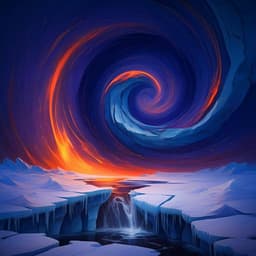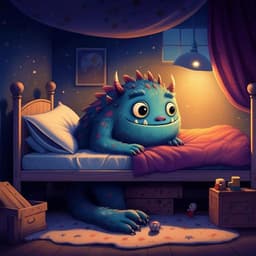
Biology
Viruses under the Antarctic Ice Shelf are active and potentially involved in global nutrient cycles
J. Lopez-simon, M. Vila-nistal, et al.
Dive into the fascinating world beneath the Ross Ice Shelf, where a diverse community of endemic viruses plays a crucial role in microbial metabolism and global nutrient cycles. This groundbreaking research by Javier Lopez-Simon, Marina Vila-Nistal, Aleksandra Rosenova, Daniele De Corte, Federico Baltar, and Manuel Martinez-Garcia unveils the intricate interactions of viruses and their chemosynthetic hosts in extreme polar environments.
~3 min • Beginner • English
Introduction
Ice shelves, particularly the Ross Ice Shelf (RIS), are vast, climate-critical systems that modulate global carbon and nutrient cycles. Recent work revealed diverse, functionally active microbial communities beneath RIS that sustain chemosynthetic primary production, but the diversity, activity, and ecological roles of viruses in this permanently dark, extreme environment remain poorly understood due to logistical sampling challenges. The study aims to characterize viral diversity, biogeography, activity, lifestyles, and host interactions under the RIS, and to assess whether viruses influence key biogeochemical processes by infecting dominant chemolithoautotrophs and by carrying auxiliary metabolic genes (AMGs). Understanding these virus–host dynamics is essential to predict ecosystem functioning under climate-driven changes affecting Antarctic ice shelves.
Literature Review
Marine viruses are central to ocean ecology and biogeochemistry, influencing the biological carbon pump through viral shunt and shuttle processes. Global surveys (e.g., Tara Oceans, GOV 2.0, Malaspina) revealed high viral diversity and widespread influence on carbon export, with particular emphasis on abundant viruses across surface to deep waters. Viruses in meso- and bathypelagic zones, and in polar systems such as the Southern Ocean, show adaptations to low temperatures and evidence of selection on genes linked to lysogeny-lytic decisions. Conceptual models include Piggyback-the-Winner in productive systems and Piggyback-the-Persistent in ultra-oligotrophic environments. However, little is known about viruses beneath Antarctic ice shelves due to limited access; prior RIS microbiology established abundant ammonium- and sulfur-oxidizing primary producers (e.g., Nitrosopumilus and Thioglobus), suggesting specific viral interactions could modulate elemental cycling. Previous single-virus genomics and metagenomics identified cosmopolitan pelagiphages (e.g., vSAG 37-F6) and AMGs in various marine viral groups, laying groundwork for exploring AMG-mediated metabolic reprogramming in extreme polar, aphotic settings.
Methodology
Sampling was conducted in 2017 beneath the Ross Ice Shelf at site HWD-2 (−80.6577, 174.4626), 300 km from the shelf front. Seawater was accessed by hot-water drilling a 30 cm borehole, sampling at three depths below the ice bottom: 30 m, 180 m, and 330 m (equivalent to 400 m, 550 m, and 700 m from the top of the shelf). Dedicated viromes were not collected; instead, cell-associated fractions were processed for single-cell genomics (SAGs), metagenome-assembled genomes (MAGs), metagenomes, and metatranscriptomes. Assembled and co-assembled contigs (≥1 kb) from SAGs, MAGs/bins, and transcriptomes were mined for viral sequences.
Viral detection and curation: Initial viral contig detection used VirSorter2.0 and CheckV across RNA, ssDNA, dsDNA viruses, Lavidaviridae, and NCLDV, yielding 37,674 putative viral contigs (≥1 kb). Length filters were applied: dsDNA/NCLDV/Lavidaviridae ≥10 kb; RNA ≥1.5 kb; ssDNA ≥2.5 kb. Quality filtering with CheckV retained contigs as bona fide viral if at least one viral hallmark gene was present and the host-to-viral gene ratio <1 for non-proviruses; for proviruses, presence of at least one hallmark gene sufficed. Contigs with 0 host genes and 0 hallmarks were excluded, resulting in 607 bona fide viral contigs. A third validation with PPR-meta confirmed >94% viral origin.
Taxonomy and annotation: Contigs were grouped by VirSorter2 (dsDNA, ssDNA, RNA, Lavidaviridae, NCLDV) and formally classified using geNomad (ICTV-updated taxonomy). Annotation used DRAM-v to identify viral hallmark genes and potential AMGs. Intergenomic similarities were estimated with VIRIDIC.
Viral networks and biogeography: Protein-sharing networks were built with vConTACT v2.0 including 5,461 reference/uncultured viruses (from Tara/GOV2.0, Malaspina, GenBank/ICTV, Southern Ocean datasets). Viral proteins were clustered via all-vs-all BLASTP (E ≤ 1e−5; bit score ≥50), MCL clustering (inflation 2). Similarity scores and clusters were visualized in Cytoscape. RIS viral ORFs (n=11,017) were compared to GOV2.0 and Southern Ocean proteomes (BLASTP: e ≤ 5e−5; identity and query coverage ≥50%).
Abundance and activity: In silico abundances and transcriptional activities were estimated via fragment recruitment against metagenomes and metatranscriptomes (KPKG), using thresholds for species-level (coverage ≥85%, identity ≥95%) and genus-level (coverage ≥50%, identity ≥70%) recruitment.
Host prediction: Multi-evidence host assignment integrated CRISPR spacer–protospacer matches (CRT tools; BLASTn short-sequence parameters), tRNA matches (alignment ≥60 bp, identity ≥97%, mismatches <10), codon usage similarity, WIsH log-likelihood (−1.30 to −1.20), prophage detection (CheckV), and presence of host-homolog AMGs in viral genomes. Viral contigs placed in MAGs by binning alone were not considered sufficient; corroborating evidence was required. Hydropathicity indices were computed with ExPASy Protscale. Selected protein 3D structures (e.g., capsids and AMG candidates) were predicted with Robetta/AlphaFold and compared to host homologs.
Data availability: Raw and assembled sequences are under ENA Bioproject PRJEB35712; curated viral contigs and source data are provided via Figshare and the article’s Source Data file.
Key Findings
- Recovered 607 bona fide viral contigs from cell-associated metagenomes, metatranscriptomes, SAGs, and MAGs beneath the Ross Ice Shelf; 11,017 ORFs annotated with hallmark viral genes.
- Taxonomy: ~90% of contigs belonged to Caudoviricetes (Duplodnaviria, dsDNA); additional groups included Monodnaviria (ssDNA ~3%), Riboviria (RNA), and Varidnaviria (including NCLDV and virophages). ssDNA/RNA contigs were smaller (mean ≈4 kb) than dsDNA (mean ≈19.4 kb).
- Novelty and endemicity: ~50% of viral genes showed no matches in databases. Among GOV2.0 matches, most hits were to viruses from mesopelagic (44%), deep chlorophyll maximum (27%), and surface (26%) samples, suggesting similarity to polar and mesopelagic communities rather than surface.
- Network biogeography: 56% of RIS viruses were singletons/outliers in the protein-sharing network, indicating many novel lineages; dataset encompassed ≈600 putative viral genera (ICTV genome-based thresholds), largely singleton clusters, implying high genomic diversity. Strong connections to Southern Ocean viral datasets reflect cold adaptation and regional selection.
- Lifestyle: Only ~3% of viruses contained integrases or were detected as prophages, arguing against Piggyback-the-Winner dominance and consistent with a low-productivity environment (cell abundances ~9×10^4–1.2×10^6 cells mL−1; long turnover times).
- Abundance and activity: Fragment recruitment across depths showed broadly uniform abundances for most viruses. Top 3 most abundant in cell metagenomes were Duplodnaviria (two with unknown hosts; one likely archaeal). Top 3 most transcribed included an RNA virus (Riboviria; contig K121_168914, Chrymotiviricetes) infecting an unknown eukaryote, a Caudoviricetes virus infecting Nitrosphirales archaea (contig metag_c_00000064633), and a Pelagiphage (k121_349967; vSAG 37-F6-like) infecting Pelagibacter.
- Pelagiphage linkage: 19 RIS viruses grouped with the globally abundant pelagiphage vSAG 37-F6, sharing the hallmark capsid ORF9 (avg identity 61.3%, query coverage 93.3%); structural predictions corroborated homology.
- Host-virus pairs: Despite low overall host assignment rates (~10%), 60 virus–host pairs were resolved, including key chemolithoautotrophs central to primary production: Nitrosopumilus (ammonia-oxidizing archaea) and Thioglobus (sulfur-oxidizing bacteria), supporting an active infection regime in primary producers consistent with kill-the-winner dynamics.
- Auxiliary metabolic genes (AMGs): 52 viruses carried putative niche-specific AMGs. Common AMGs included molecular chaperones (GroEL, DnaK) and cold-shock proteins, consistent with cold adaptation. Notably, viruses infecting Thioglobus and Nitrosopumilus encoded iron–sulfur (Fe/S) cluster assembly/transport proteins and ferredoxin, potentially enhancing sulfur metabolism and respiration. Additional AMGs included PhoH and acid phosphatase (phosphorus acquisition) in viruses infecting Marinisomataceae and Nitrosphirales, glutamine synthetase in viruses infecting SAR86 (nitrogen assimilation), and putative isocitrate lyase in viruses infecting Pelagibacter and Woesiales. Numerous nucleotide metabolism and DNA-processing AMGs were also detected.
Discussion
The study demonstrates that the viroplankton beneath the Ross Ice Shelf is highly diverse, largely novel, and compositionally aligned with polar and mesopelagic communities. The scarcity of integrases and prophages, together with active transcription of viruses infecting abundant chemolithoautotrophs (Nitrosopumilus, Thioglobus) and Pelagibacter, supports a kill-the-winner dynamic in a low-productivity, cold environment. The detection of cold-adaptation AMGs (chaperones, cold-shock proteins) and Fe/S cluster assembly proteins and ferredoxin in viruses suggests that infections may directly modulate host energy metabolism, particularly sulfur oxidation and respiration, analogous to phage-encoded photosynthesis genes in cyanophages in sunlit waters. Phosphorus- and nitrogen-related AMGs (PhoH, acid phosphatase, glutamine synthetase) further imply viral facilitation of nutrient acquisition and assimilation under resource constraints. Together, these findings address the central question by showing viruses under the RIS are transcriptionally active, host-interactive agents shaping primary production and remineralization through both lytic pressure and metabolic reprogramming, with implications for global nutrient cycling in polar, aphotic systems.
Conclusion
This work provides the first integrated view of viral diversity, activity, and ecological roles beneath the Antarctic Ross Ice Shelf. It reveals a virome dominated by novel Caudoviricetes with strong endemic signatures, limited evidence for lysogeny, and active infections of key chemolithoautotrophs. The presence of niche-specific AMGs related to sulfur, phosphorus, and nitrogen metabolism indicates potential viral programming of host metabolism that sustains chemosynthetic primary production and influences elemental cycling. Future research should include targeted viromics of free virus particles under ice shelves, experimental validation of AMG functions and expression during infection, cultivation-based host–virus systems, time-series to capture dynamics and environmental drivers, and assessments of how climate-driven ice shelf changes may alter virus–host interactions and biogeochemical consequences.
Limitations
- No dedicated free-viral particle viromes were collected; analyses are based on cell-associated metagenomes/metatranscriptomes, potentially biasing toward actively infecting or cell-associated viruses and under-representing the free viral pool.
- Standard protocols and preservation may favor dsDNA virus recovery; RNA viruses and some ssDNA viruses may be under-detected due to stability and methodological biases.
- Host assignment success was limited (~10%) and relies on in silico evidence (CRISPR, tRNA, codon usage, WIsH), which can produce false positives/negatives; binning-based co-occurrence was not considered sufficient.
- AMG identification is genomic and putative; functional roles were not directly validated experimentally or via transcript-level co-expression for all AMGs.
- Viral taxonomy and genus demarcation for uncultured viruses remain challenging; estimates of ~600 genera and novelty (singletons) depend on current databases and thresholds.
- Abundance/activity estimates rely on fragment recruitment thresholds and available datasets, without absolute quantification of free-viral particles.
Related Publications
Explore these studies to deepen your understanding of the subject.







